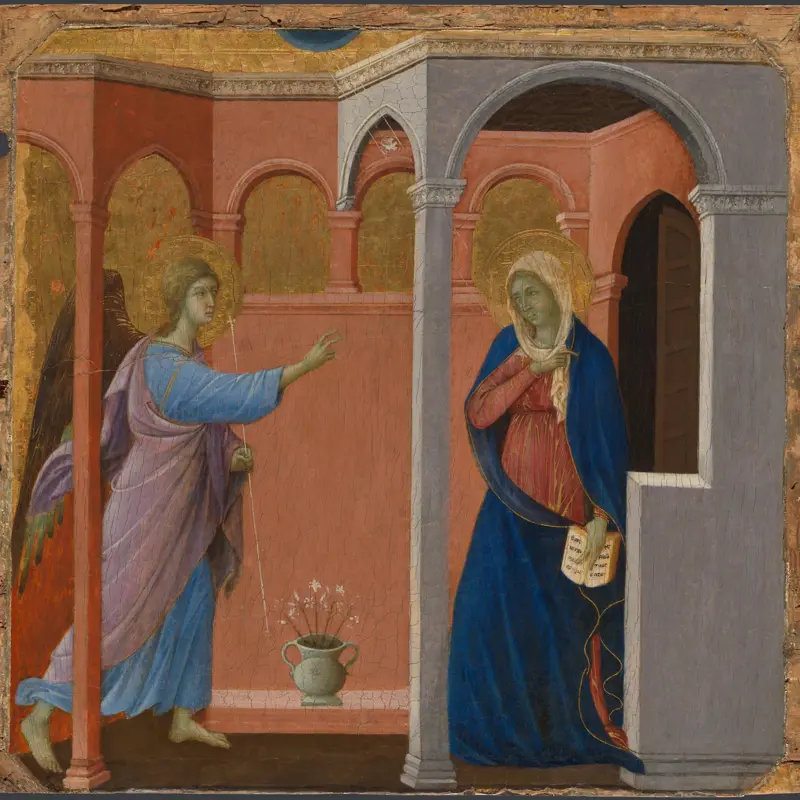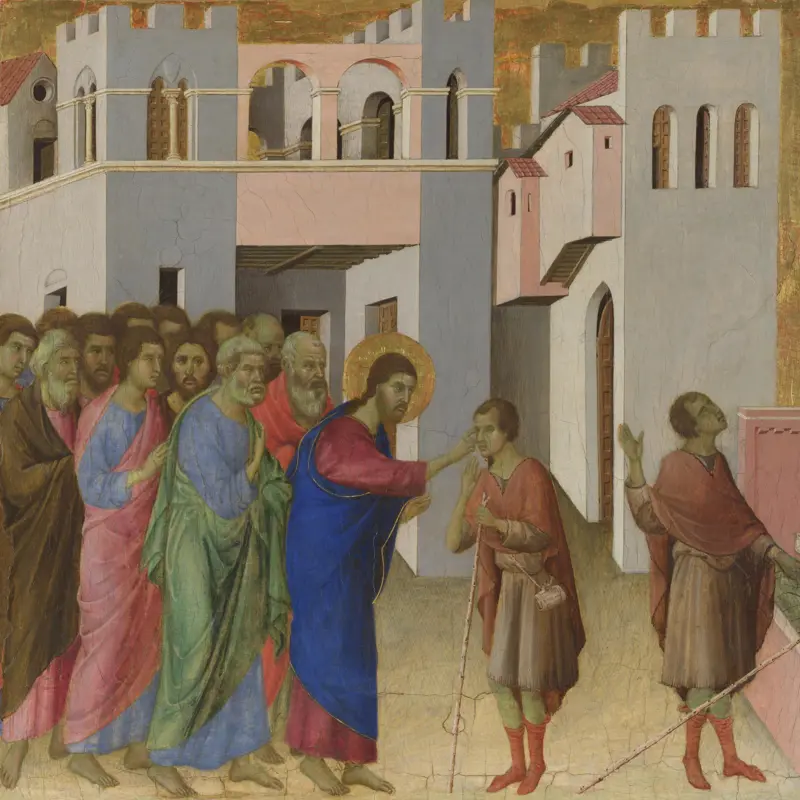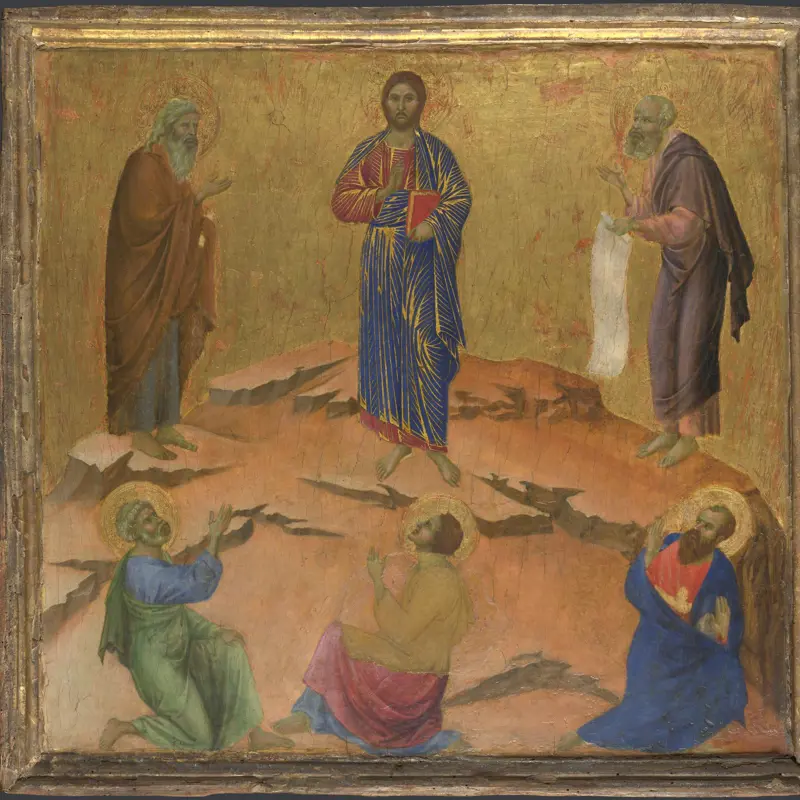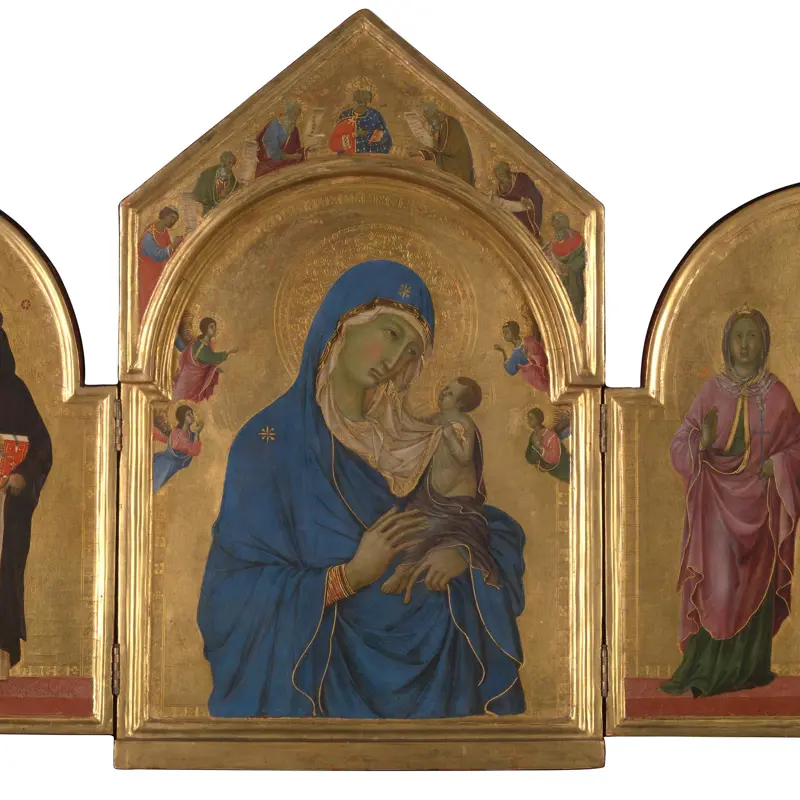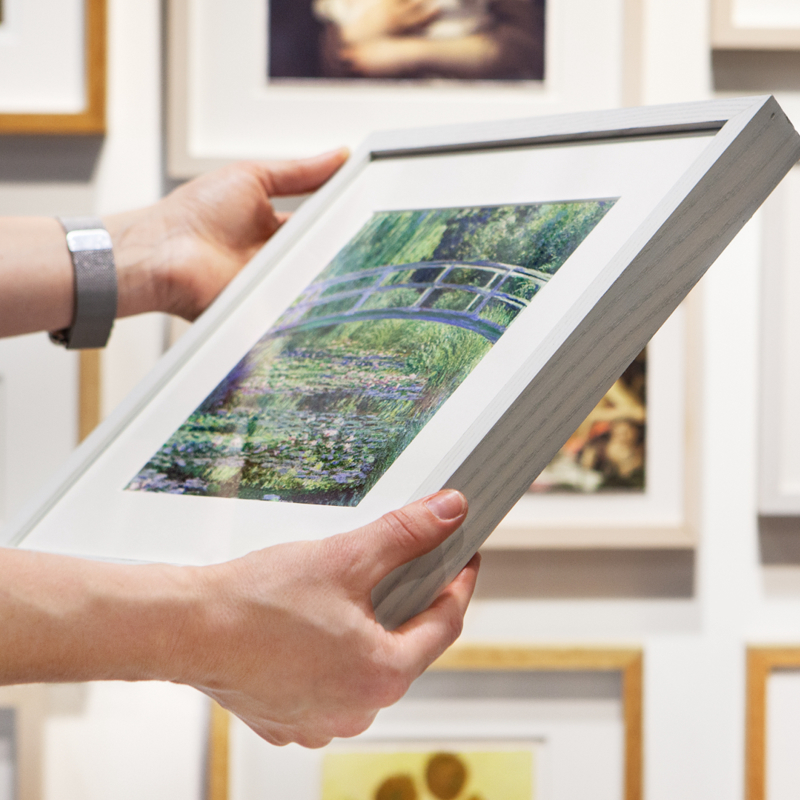Duccio, 'The Annunciation', 1307/8-11
About the work
Overview
The Archangel Gabriel announces to the Virgin Mary that she will conceive the Son of God; she holds a Bible open at words from the prophet Isaiah which echo Gabriel’s: ‘Behold a Virgin shall conceive and bear a son...’
The conception takes place at the moment she hears the words, which is why a tiny white dove, representing the Holy Ghost, flies towards her ear. Her fearful gesture is at the same time one of acceptance: her arm has drawn her cloak open to reveal her red dress beneath, highlighting her womb.
The panel was the first in a series of scenes of the infancy of Christ on the front of the predella (lowest part) of the Maestà. The Maestà was a five-tiered, double-sided altarpiece, and the focus of the devotion of the Virgin in Siena. It is the only known signed work by the city’s leading artist, Duccio di Buoninsegna.
Key facts
Details
- Full title
- The Annunciation
- Artist
- Duccio
- Artist dates
- Active 1278, died 1319
- Part of the series
- Maestà Predella Panels
- Date made
- 1307/8-11
- Medium and support
- Egg tempera on wood (probably poplar)
- Dimensions
- 44.5 × 45.8 cm
- Inscription summary
- Inscribed
- Acquisition credit
- Bought, 1883
- Inventory number
- NG1139
- Location
- Room 58
- Collection
- Main Collection
- Previous owners
- Frame
- 20th-century Replica Frame
Provenance
Additional information
Text extracted from the ‘Provenance’ section of the catalogue entry in Dillian Gordon, ‘National Gallery Catalogues: The Italian Paintings before 1400’, London 2011; for further information, see the full catalogue entry.
Exhibition history
-
2014Building the Picture: Architecture in Italian Renaissance PaintingThe National Gallery (London)30 April 2014 - 21 September 2014
-
2017Pietro Lorenzetti: Siena to Hull, a Masterpiece RevealedFerens Art Gallery9 January 2017 - 23 April 2017
Bibliography
-
1884National Gallery, Abridged Catalogue of the Pictures in the National Gallery: With Short Biographical Notices of the Painters: Foreign Schools, London 1884
-
1951Davies, Martin, National Gallery Catalogues: The Earlier Italian Schools, London 1951
-
1979J.H. Stubblebine, Duccio di Buoninsegna and His School, Princeton 1979
-
1980B. Cole, Sienese Painting from Its Origins to the Fifteenth Century: Duccio and His School, New York 1980
-
1981E. Carli, La pittura senese del Trecento, Milan 1981
-
1982J. Plesters, A. Roy and D. Bomford, 'Interpretation of the Magnified Image of Paint Surfaces and Samples in Terms of Condition and Appearance of the Picture - Recognition of Original Techniques and Procedures of the Artist, The Elucidation of an Early Gilding Technique', in Science and Technology in Conservation, Washington 1982, pp. 169-76
-
1983J. Mills and R. White, 'Analyses of Paint Media', National Gallery Technical Bulletin, VII, 1983, pp. 65-7
-
1983J. Mills and R. White, 'Pictures Cleaned and Restored in the Conservation Department of the National Gallery, January 1982 – December 1982', National Gallery Technical Bulletin, VII, 1983
-
1984H.W. van Os, Sienese Altarpieces 1215-1460: Form, Content, Function: 1215-1344, vol. 1, 1215-1344, Groningen 1984
-
1985R.W. Sullivan, 'The Anointing in Bethany and Other Affirmations of Christ's Divinity on Duccio's Back Predella', Art Bulletin, LXVII/1, 1985, pp. 32-50
-
1985D. Sutton, 'Aspects of British Collecting, IV: The Age of Robert Browning', Apollo, CXXII/282, 1985, pp. 96-110
-
1986Davies, Martin, National Gallery Catalogues: The Earlier Italian Schools, revised edn, London 1986
-
1986M. Prokopp, Great Masters of the Trecento, Budapest 1986
-
1986R.W. Sullivan, 'Some Old Testament Themes on the Front Predella of Duccio's "Maestà', Art Bulletin, LXVIII/4, 1986, pp. 597-609
-
1988Gordon, Dillian, National Gallery Catalogues: The Early Italian Schools before 1400, revised edn, London 1988
-
1989G. Ragionieri, Duccio: Catalogo completo dei dipinti, Florence 1989
-
1989D. Bomford et al., Italian Painting before 1400 (exh. cat. The National Gallery, 29 November 1989 - 28 February 1990), London 1989
-
1991J. Dunkerton et al., Giotto to Dürer: Early Renaissance Painting in the National Gallery, New Haven 1991
-
1994E. Langmuir, The National Gallery Companion Guide, London 1994
-
1994A. Thomas, An Illustrated Dictionary of Narrative Painting, London 1994
-
1995D. Norman, 'A Noble Panel: Duccio's Maestà', in D. Norman (ed.), Siena, Florence and Padua: Art, Society and Religion, 1280-1400, New Haven 1995, vol. 2, pp. 55-81
-
1996D. Popp, Duccio und die Antike: Studien zur Antikenvorstellung und zur Antikenrezeption in der sieneser Malerei am Anfang des 14. Jahrhunderts, Munich 1996
-
1997D. Bomford, Conservation of Paintings, London 1997
-
1997A. Weber, Duccio di Buoninsegna: About 1255-1319, Cologne 1997
-
1999D. Arasse, L'annonciation italienne: Une histoire de perspective, Paris 1999
-
1999J. Drury, Painting the Word: Christian Pictures and Their Meanings, New Haven 1999
-
2000R. Morphet et al., Encounters: New Art from Old (exh. cat. The National Gallery, 14 June - 17 September 2000), London 2000
-
2000R.P. Tarr, '"Ecce Virgo Concipiet": The Iconography and Context of Duccio's London Annunciation', Viator: Medieval and Renaissance Studies, XXXI, 2000, pp. 187-231
-
2001
C. Baker and T. Henry, The National Gallery: Complete Illustrated Catalogue, London 2001
-
2004M. Feuillet, L'annonciation Sous Le Regard des Peintres, Marne 2004
-
2011Gordon, Dillian, National Gallery Catalogues: The Italian Paintings before 1400, London 2011
-
2024J. Cannon, C. Campbell and S. Wolohojian (eds), Siena: The Rise of Painting 1300-1350 (exh. cat. Metropolitan Museum of Art; National Gallery, London), London 2024
Frame
This frame was made at the Gallery in 1966. It is a pinewood and water-gilt reproduction modelled on the frame of a panel from the same fourteenth-century altarpiece as Duccio’s Annunciation. The corner coverage of the reproduction frame echoes the column-shaped divisions of the original frame. The current frame underwent stripping and regilding between 1970 and 1980.
The altarpiece remained in place until 1771, when it was dismantled, causing damage to the paintings and leading to the disposal of the original altar frame.
About this record
If you know more about this work or have spotted an error, please contact us. Please note that exhibition histories are listed from 2009 onwards. Bibliographies may not be complete; more comprehensive information is available in the National Gallery Library.
Images
About the series: Maestà Predella Panels
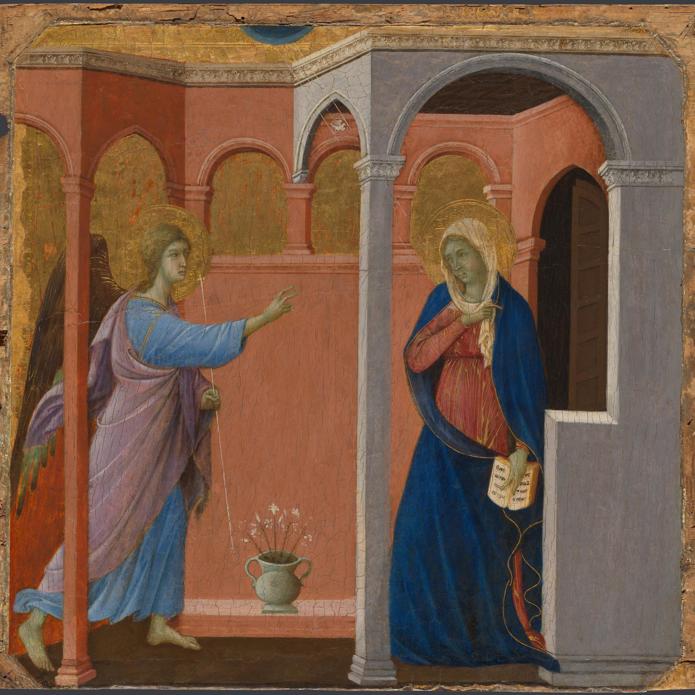
Overview
These three small panels come from the altarpiece known as the Maestà (‘Majesty’), made for Siena Cathedral. It is the only surviving signed work by the city’s leading artist, Duccio di Buoninsegna. These paintings formed part of the predella, the lowest part of the altarpiece.
The Maestà was painted on both sides: The Annunciation comes from the front predella, while the Healing of the Man born Blind and the Transfiguration were originally placed next to each other on the back of the predella. The predella itself was shaped like a rectangular box, with images on both sides, providing support for the large, double-sided picture.
When the picture was completed in 1311 it was carried in a festive procession across the streets of Siena to the cathedral, where it was placed above the high altar. There it became the focus of the Siena’s devotion to the Virgin Mary, who was considered the protector of the city.

